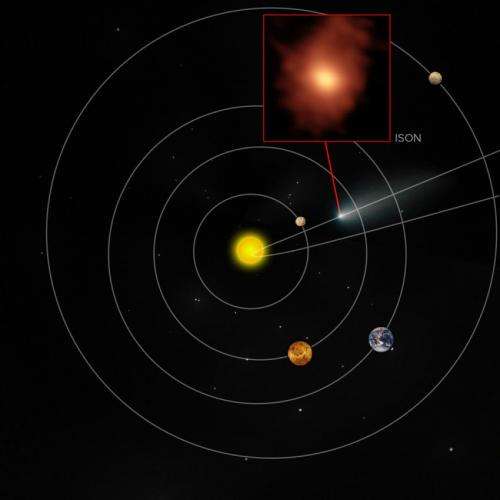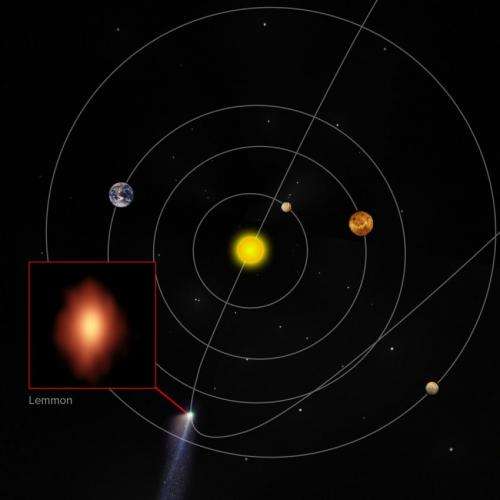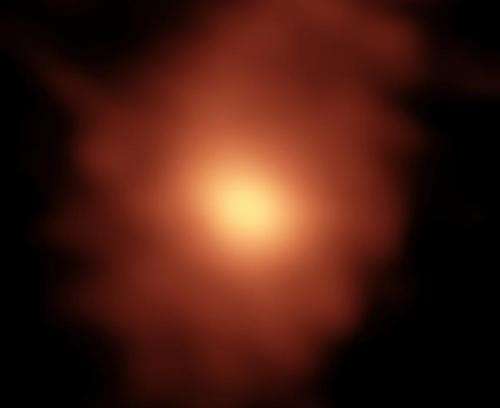ALMA confirms comets forge organic molecules in their dusty atmospheres

(Phys.org) —An international team of scientists using the Atacama Large Millimeter/submillimeter Array (ALMA) has made incredible 3D images of the ghostly atmospheres surrounding comets ISON and Lemmon. These new observations provided important insights into how and where comets forge new chemicals, including intriguing organic compounds.
Comets contain some of the oldest and most pristine materials in our solar system. Understanding their unique chemistry could reveal much about the birth of our planet and the origin of organic compounds that are the building blocks of life. ALMA's high-resolution observations provided a tantalizing 3D perspective of the distribution of the molecules within these two cometary atmospheres, or comas.
"We achieved truly first-of-a-kind mapping of important molecules that help us understand the nature of comets," said team leader Martin Cordiner, a Catholic University of America astrochemist working at NASA's Goddard Space Flight Center in Greenbelt, Maryland.
The critical 3D component of the ALMA observations was made by combining high-resolution, two-dimensional images of the comets with high-resolution spectra obtained from three important organic molecules—hydrogen cyanide (HCN), hydrogen isocyanide (HNC), and formaldehyde (H2CO). These spectra were taken at every point in each image. They identified not only the molecules present but also their velocities, which provided the third dimension, indicating the depths of the cometary atmospheres.
The new results revealed that HCN gas flows outward from the nucleus quite evenly in all directions, whereas HNC is concentrated in clumps and jets. ALMA's exquisite resolution could clearly resolve these clumps moving into different regions of the cometary comas on a day-to-day and even hour-to-hour basis. These distinctive patterns confirm that the HNC and H2CO molecules actually form within the coma and provide new evidence that HNC may be produced by the breakdown of large molecules or organic dust.

"Understanding organic dust is important, because such materials are more resistant to destruction during atmospheric entry, and some could have been delivered intact to the early Earth, thereby fueling the emergence of life," said Michael Mumma, director of the Goddard Center for Astrobiology and a co-author on the study. "These observations open a new window on this poorly known component of cometary organics."
"So, not only does ALMA let us identify individual molecules in the coma, it also gives us the ability to map their locations with great sensitivity," said Anthony Remijan, an astronomer with the National Radio Astronomy Observatory (NRAO) in Charlottesville, Virginia, and a study co-author.
The observations, published today in the Astrophysical Journal Letters, were also significant because modest comets like Lemmon and ISON contain relatively low concentrations of these crucial molecules, making them difficult to probe in depth with Earth-based telescopes. The few comprehensive studies of this kind so far have been conducted on extremely bright comets, such as Hale-Bopp. The present results extend them to comets of only moderate brightness.

Comet ISON (formally known as C/2012 S1) was observed with ALMA on November 15-17, 2013, when it was only 75 million kilometers from the Sun (about half the distance of the Earth to the Sun). Comet Lemmon (formally known as C/2012 F6) was observed on June 1-2, 2013, when it was 224 million kilometers from the Sun (about 1.5 times the distance of the Earth to the Sun).
"The high sensitivity achieved in these studies paves the way for observations of perhaps hundreds of the dimmer or more distant comets," said Goddard's Stefanie Milam, a study co-author. "The findings suggest that it should also be possible to map more complex molecules that have so far eluded detection in comets."
More information: Paper - iopscience.iop.org/2041-8205/792/1/L2/article
Journal information: Astrophysical Journal Letters
Provided by National Radio Astronomy Observatory





















